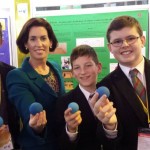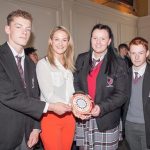By Bernie Ní Fhlartharta, the Tuam Herald.
A GALWAY school is bucking the trend as they have more girls than boys taking up science and getting involved in the BT Young Scientist of the Year event.
In fact, Coláiste Bhaile Chláir in Claregalway are in a unique position as they offer the STEM (science, technology, engineering and maths) programme on a full-time basis so were more than delighted to get involved in a new programme to further inspire Junior Cycle students to explore career possibilities through those subjects.
Seven Galway schools, Coláiste Bhaile Chláir and Clarin College, Athenry among them, took part in the Futurewize programme developed by Junior Achievement Ireland (JAI) with the support of Science Foundation Ireland and Fidelity investments.
It primarily encourages girls to explore the value of studying science, technology, engineering and maths (STEM) so to that end, 65 per cent of places available were filled by girls during the year.
Recent Irish research carried out analysing female attitudes towards STEM points to girls being able to visualise themselves having a career in STEM at age 11 but no longer see this as a possibility at 15 years.
But Niamh Burke, science and maths teacher in the Claregalway school, said that their experience appeared to buck the national trend with more girls than boys interested in STEM at their college.
“We have been involved with the STEM programme for the past four years but this was the first year we rolled out the three hear programme starting with our first years – all 189 of them. It certainly gives our students a better understanding of the career prospects in those industries and they could relate to the men and women who volunteered, as part of this particular programme, to talk to the classes about their jobs. It certainly gave them a better understanding of why they should study the STEM subjects,” she said.
Niamh Grealish, Programme Co-ordinator for JAI, in Galway explained that this programme was aimed at post primary pupils aged between 12 and 14 to encourage them to keep up the STEM subjects.
She said that many pupils, especially girls, fell out of these subjects as they got older and that Futurewize aimed to change that.
“It involves a one hour a week for five weeks commitment right through the school year with the help of volunteers from businesses like Fidelity Investments Ireland who visit the schools.
“It’s definitely making a difference and we know this from the positive feedback from students, teachers and the volunteers,” she added.
Nationwide, 1,900 pupils from 46 second level schools took part and 99 per cent of students reported their knowledge of STEM increased as a result of their participation.
Futurwize Programme Ambassador Dr. Aoibhinn Ní Shúilleabháin said: I have seen first-hand how the Futurewize programme provides a wonderful opportunity for students to learn more about STEM subjects in an engaging, interactive way and also be inspired by positive role models from industry, who can provide them with insight into what it is like to pursue a career in STEM. It is hugely important we address diversity issues in STEM subjects, particularly related to gender and the socio-economic status of those choosing to study and work in these fields. With 65 per cent female participation, and the significant participation of DEIS schools, Futurewize is addressing diversity in a constructive way.”



